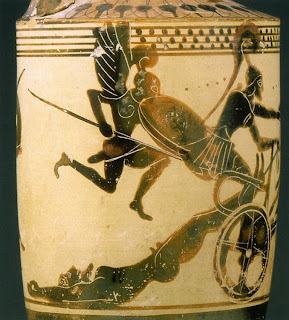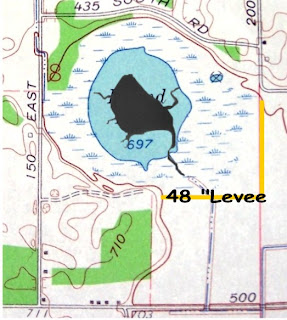 ........Photo: King in Chicago in February 1966........
........Photo: King in Chicago in February 1966........Am I crossing a dangerous line by writing about race in Knox? Of course I am. Am I saying anything that anybody doesn’t know already? Probably not. I suppose someone may very well ask, “Then why write about it? Why drag this stuff up? Aren’t you just making Knox look bad?” I write about it because Knox is my subject, my home, and this is a BIG part of Knox, then and now. And be aware that I am not making Knox look bad. The racists in Knox are the ones that make Knox look bad. Change is coming to Knox, perhaps more quickly than we can guess. Continued racial intolerance will hurt Knox’s citizens’ prospects for happiness and prosperity.
The 1960’s and 1970’s still are close enough in time to cause some discomfort. Knox, like so many other towns and cities in America, didn’t tolerate any blacks in town after dark. Black workers pass through town and maybe even have a job in town, but they had better not try to live here. Ugly? Yes indeed.
The great national social changes resulting from the civil rights struggles of the 1960’s had little or no impact in Knox. Certainly Martin Luther King, Jr.’s Nobel Prize in 1964 garnered no particular attention. Who knew or cared that King moved into the Chicago slums in 1966? But when the Chicago Freedom Movement (CFO) pressed to cross the residential racial lines in Chicago neighborhoods some howling was heard. At Bessie’ Restaurant in Knox, on weekends the Bass Lake cottage owners coming in from Chicago’s South side let anybody and everybody know their thoughts on the matter. In the late 60’s the race riots and the burning neighborhoods 80 miles away on Chicago’s south and west sides were cause to reinforce the fear that things were going to Hell.
I have heard a story from the 1970’s of a Black State Trooper and his family locating in Knox for a short time. The unsubstantiated story is that the volunteer fire department had made it clear that they would not be putting out any fires at that household. I have no idea if this is a true story. But the widespread acceptance of such a story is certainly an illustration of the background against which a black family could decide about locating in Knox. In the early 1970’s I witnessed a college coed home on vacation accompanied by her black dormitory roommate walking down the sidewalk in downtown Knox with little kids running behind them yelling, “nigger, nigger, nigger”.
In that same era, there was a devastating plant closing in Knox when Rockwell International left Knox. The plant was vacant and Knox badly needed to get a new industry located in the building. The principals of a black-owned industrial company came to Knox to inspect the site and check out the town. At the aforementioned Bessie’s Restaurant I overheard a prominent realtor bragging that he told these black industrialists that there were no homes for sale in Knox.
It is clear that the 1960’s and 1970’s were a horrible, perhaps impossible, time to be black in Knox. The blame doesn’t simply fall on the lower social-economic classes, the so-called rednecks. A leading citizen, a prominent realtor, was confident enough in the total acceptance of his racism to openly brag about it, in public, to his peers. He was essentially making sure that a new factory with black owners did not locate in Knox. This was a time of recession and high unemployment. Having a new industrial plant in Knox would have been a most-welcome development. I am totally certain that I would rather have as neighbors the owners of that prospective factory than that piece-of-work realtor and his accepting buddies at Bessie’s Restaurant.
Note on the usage of the words Negro and nigger. The word Negro is often considered offensive. I use it here to reference historic and scholarly documents and in order to capture the archaic flavor of life in Knox. The word nigger is always considered offensive; it is only used here because it is a quote from actual racist abuse. Please forgive any offense this may cause.



 .....Main Street appx 1918 note "Underground Railroad".......
.....Main Street appx 1918 note "Underground Railroad".......















 I have put a number “1” on the map as an illustration of just how perverse the Agricultural Zone is. This plot of land is just South of the Knox High School Campus and the Cemetery. This old farm is on relatively high ground, is well drained and has poor crop yields. It hasn’t been a family farm in any sense in generations. It is in a perfect location for development as residential property. It is worth many more thousands an acre for that use than as sub-standard agricultural ground. Just southwest of this parcel is a well-established subdivision. Just south across the road is another similar plot of agricultural ground that should be residential and just south of that is a series of luxury houses.
I have put a number “1” on the map as an illustration of just how perverse the Agricultural Zone is. This plot of land is just South of the Knox High School Campus and the Cemetery. This old farm is on relatively high ground, is well drained and has poor crop yields. It hasn’t been a family farm in any sense in generations. It is in a perfect location for development as residential property. It is worth many more thousands an acre for that use than as sub-standard agricultural ground. Just southwest of this parcel is a well-established subdivision. Just south across the road is another similar plot of agricultural ground that should be residential and just south of that is a series of luxury houses.



 above: Black Outline is Present Profile
above: Black Outline is Present Profile Below: 1871 Platt Map
Below: 1871 Platt Map  Below: going, going...
Below: going, going...

